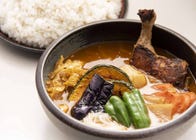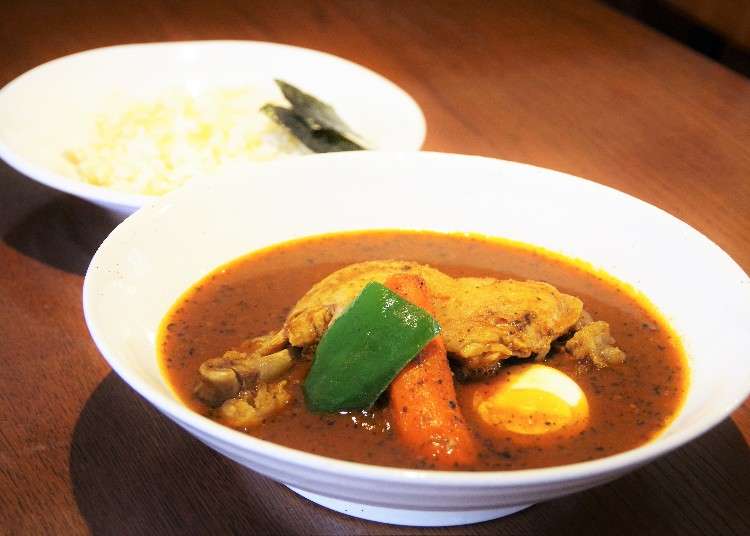
Why You Need to Try Sapporo Soup Curry: All About The Iconic Food of Japan's North (Recommended Restaurants & More)
- Written by: Nobuka Kawashima
Soup curry has become an iconic ‘soul food’ dish in Sapporo, Hokkaido. A favorite among locals and visitors alike, soup curry consists of a smooth soupy curry loaded with spices and packed with chunky vegetables and meats and eaten together with rice.
Within Sapporo are dozens of eateries serving soup curry, each offering a unique take on the recipe with different tastes and ingredients. Visitors will often sample several renditions to discover the soup curry that complements their palate.
Here, we’ll answer all your questions about soup curry, such as how to eat it, its history, characteristics, and recommended places to check out!
What Is Soup Curry?
Essentially a spicy soup with rice, soup curry is one of Sapporo’s most famous local dishes. The recipe is totally different from regular, thick Japanese-style curry, making it more of a soup dish than a curry.
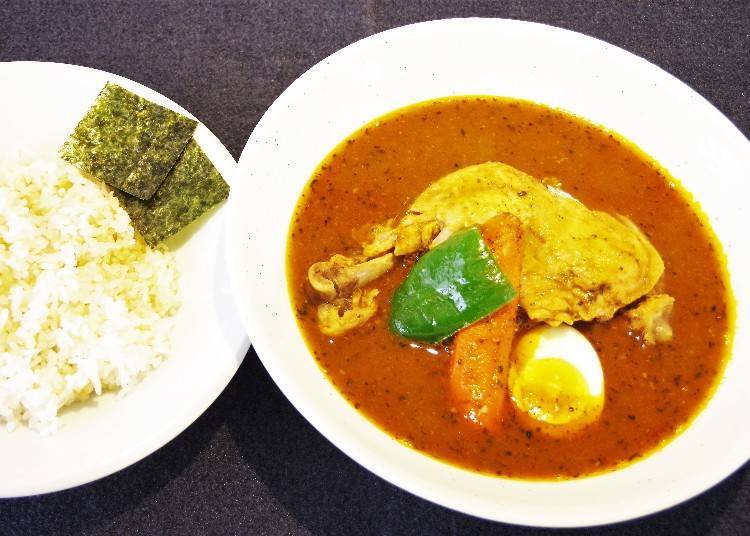
One of the most distinctive elements of soup curry is the rough cut, chunky vegetables, and meats served inside. While each piece is typically too large to be eaten in one mouthful, they are thoroughly stewed until soft, allowing you to easily break them apart with a fork or spoon to eat.
In this article, we’ll take a closer look at everything related to soup curry. And to ensure we’re bringing you the most accurate information, we spoke with Ide Go, the manager of soup curry outlet “Rakkyo” and president of the “Curry City Sapporo Promotion Committee.”
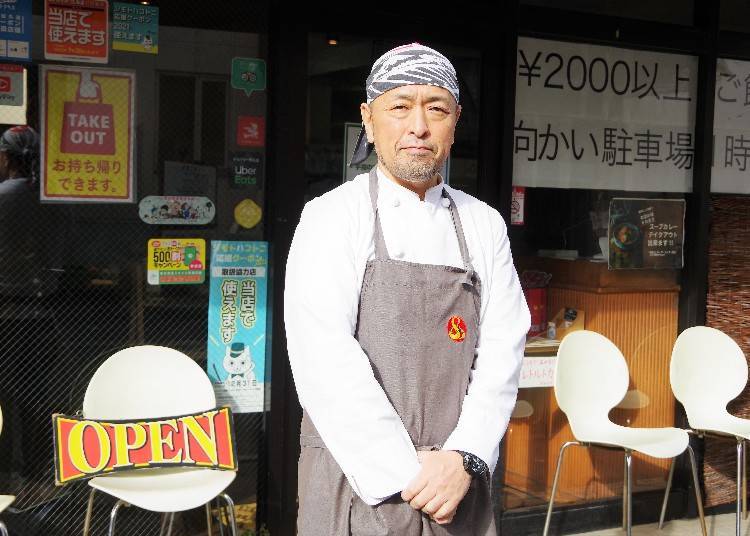
What Kind of Ingredients Are in Soup Curry?
Generally speaking, most eateries will include vegetables in their soup curries, including those deep-fried or stewed. Depending on the store, this can range from just two different varieties to a whopping ten or more, often completely covering the soup itself! Some stores will also offer additional ingredients for an added fee.
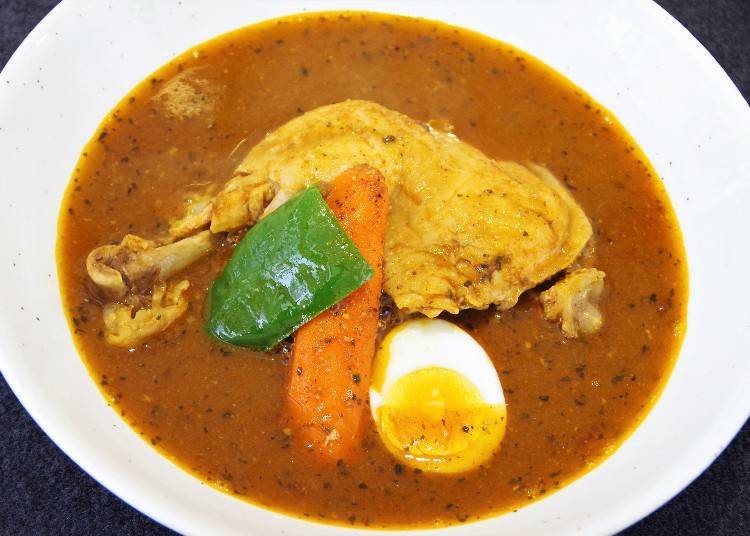
Vegetables used for soup curry often include carrot, capsicum, potato, burdock, pumpkin, broccoli, eggplant, okra, lotus root, mushrooms, turnip, tomato, cabbage, mizuna, and more. As you can see, root vegetables are generally used more than leafy vegetables.
Meats and seafood like a chicken leg, diced pork, lamb chops, shrimp, boiled eggs, and more complement the vegetables. Like vegetables, additional meats can sometimes be added for an extra charge.
What Kind of Stock and Spices Does Soup Curry Use?
The base for soup curry often comes from chicken, consommé, tomato, shrimp, or a combination of several, depending on the store. Spices include turmeric, cumin, coriander, cardamom, clove, laurel, cayenne pepper, and more.
Many outlets will create their own distinctive blend from a combination of 20-30 different spices to give their dishes a unique, one-of-a-kind flair.
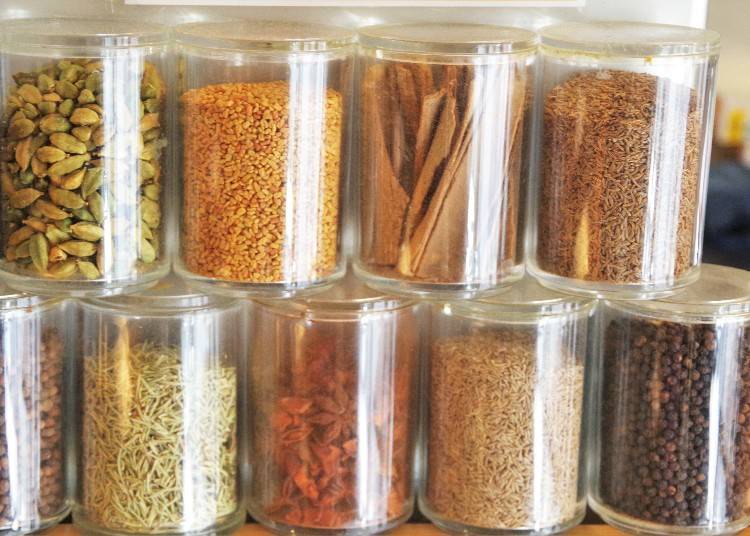
The combination of the soup base and spice mix determines the curry's character. A potent soup base brimming with concentrated umami flavors could be delicately blended with a careful selection of subtle spices, or a muted soup base could burst with an explosion of intense spices - or anywhere in between!
Plus, the method of extracting the soup base and spice types further differs between stores, making each iteration an utterly unique experience.
How Hokkaido Soup Curry is Made
Soup curry is made using entirely different techniques from regular Japanese curry, which uses flour to yield a thick, gooey texture.
Generally speaking, soup curry is made by filling a large pot with water and boiling chicken, vegetables, or whatever else to form a soup base. A variety of spices are then added for the finishing touches.
However, there is a virtually unlimited number of combinations between soup and spice, with each arrangement showcasing the talents and originality of the cook.
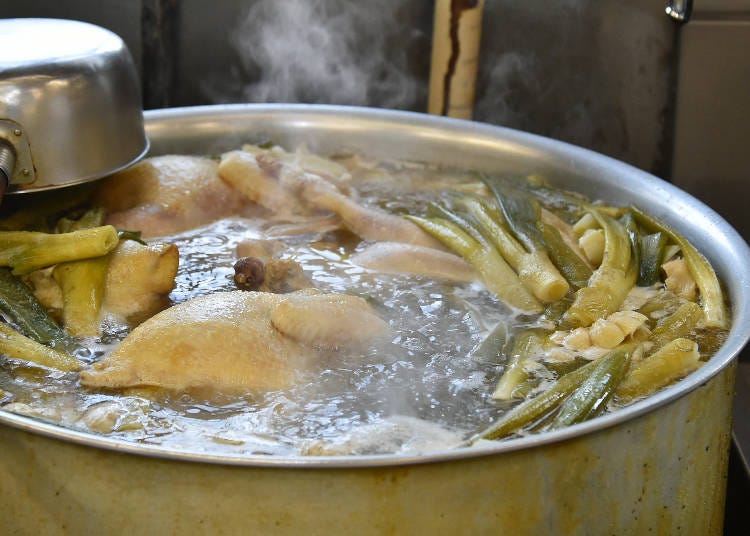
“Soup curry cooks are like musical artists,” states Ide. Indeed, many cooks specializing in soup curry set out to pursue their own unique taste after learning from an old master.
The Sapporo soup curry scene is somewhat reminiscent of a young artist being inspired by their favorite band endeavoring to hone their own musical talents before making their major debut.
As with discovering a fresh talent or new song, the charm of soup curry lies in visiting numerous outlets to enjoy and compare the tastes and techniques of cooks.
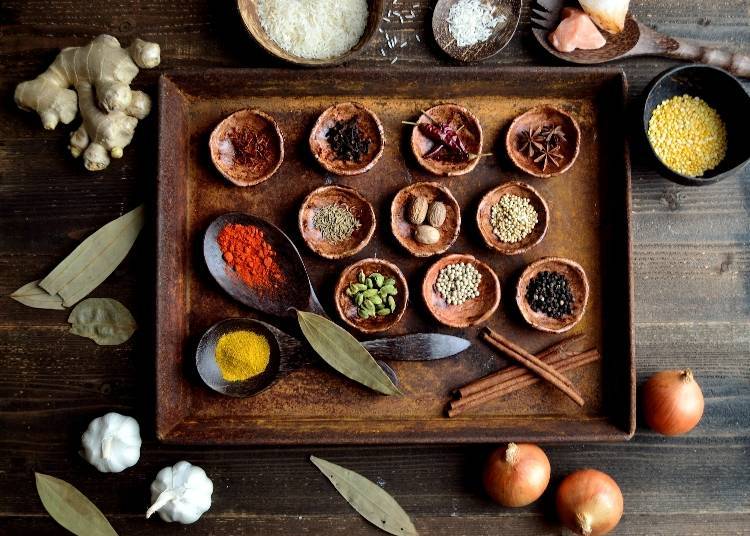
How Do You Eat Soup Curry?
While regular Japanese curry is eaten by pouring curry over rice, this is not the case with soup curry.
Generally, the soup and rice will be served in separate bowls, with the rice being scooped with a spoon, dipped into the curry, and eaten. The large ingredients, which are stewed until soft, can also be cut up and eaten individually with a spoon or fork.
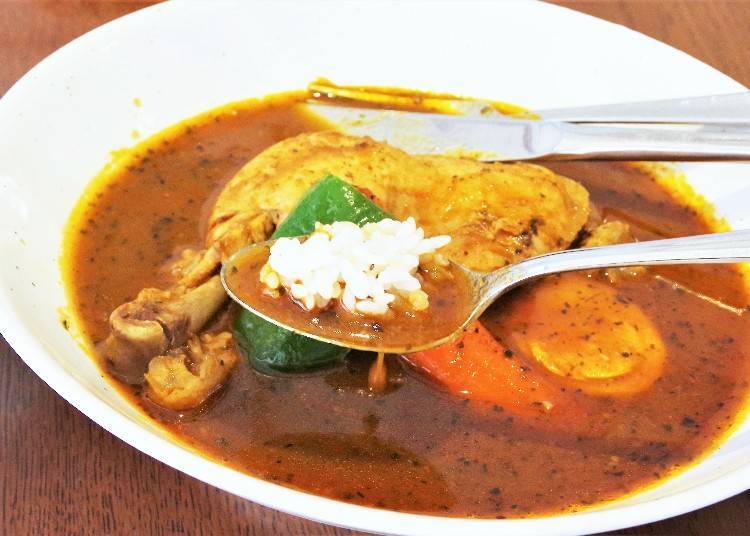
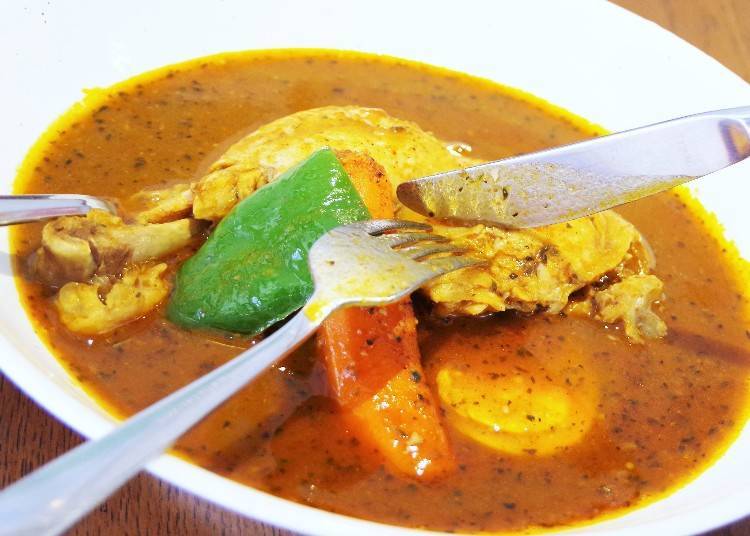
At most soup curry outlets, you’ll be able to customize the level of spiciness and rice size, and some will even allow you to choose the type of soup base and more.
Your curry will then be prepared as per your required spice level, making it a suitable dish for spice-lovers and those who can’t stand it.
However, remember that soup curry is generally spicier than regular Japanese curry. Most restaurants will display the available spice levels and rice size on the menu, so do check before ordering.
Brief History: When Was Soup Curry Created?
The prototype for soup curry was created in Sapporo in 1971. The “Yakuzen Curry” served at a cafe in Sapporo called “Ajanta,” which consisted of more than 30 spices added to a soup, is said to have been the origin. When it first appeared, it lacked the chunks of ingredients seen today and was more a kind of medicinal soup intended to provide nutrients and aid digestion.
Regular customers gradually began requesting the soup with ingredients. Several years later, a version of the soup with chicken and vegetables was served, becoming the soup curry we know and love today.
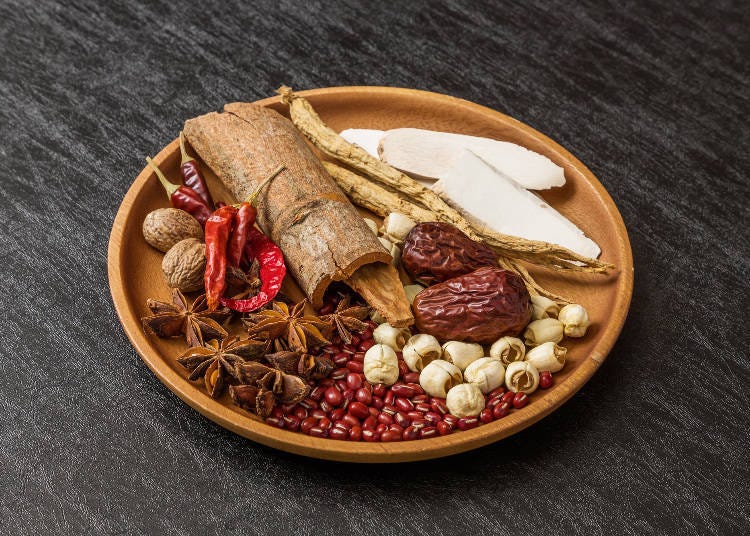
During the 1980s, numerous restaurants offering dishes similar to Yakuzen Curry were founded, with the establishment “Magic Spice” eventually coining the name “soup curry.” Slowly but surely, the dish became known around Sapporo and grew into a local favorite. However, it still retained a somewhat underground image.
According to Ide, soup curry had its big break around 2005. After several new establishments were launched around 2000, coupon magazines listing soup curry restaurants began flooding the streets in 2005, leading to the birth of many prospering stores.
According to Google Trends data, the highest search volume for the keywords “soup curry” before 2021 was in 2005, proving that curiosity was exceptionally high at the time.
Why Is Soup Curry So Popular in Sapporo?
While soup curry restaurants have been popping up all over Japan recently, during the early 2000s, soup curry was rarely spotted outside Hokkaido, and the vast majority was concentrated in Sapporo.
Ide believes that soup curry became such a sensation due to the long-established soup culture of Hokkaido. People throughout Hokkaido have long enjoyed a vast assortment of soups and hotpots, making them an indispensable facet of the region’s culinary culture.
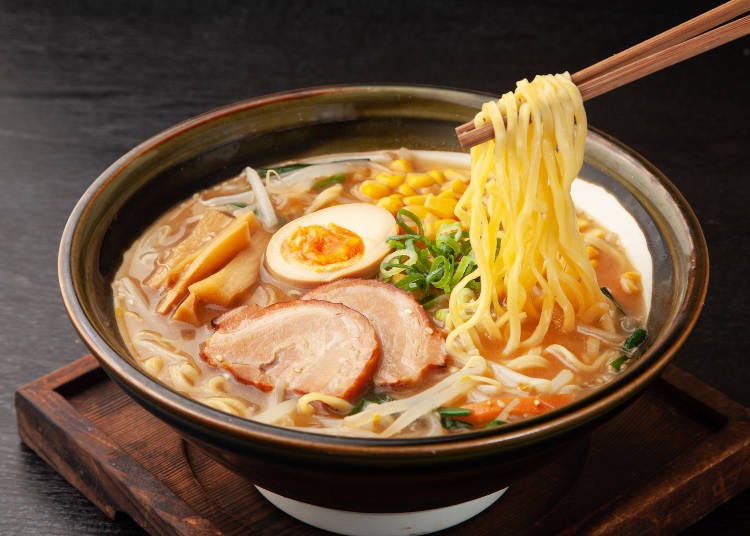
In addition to regional ramen like those in Sapporo, Asahikawa, and Hakodate, coastal and inland towns boast a diverse collection of soups and hotpots passed down the generations, including ishikari nabe (a miso-based hotpot with salmon and vegetables), sanpei-jiru (a salty soup of boiled vegetables with salmon and cod), and butajiru (a miso soup with pork and vegetables fried and simmered).
With such a deep history of soup, the sudden appearance of a curry-flavored creation was naturally accepted and adored, quickly becoming a central part of Hokkaido soup culture.
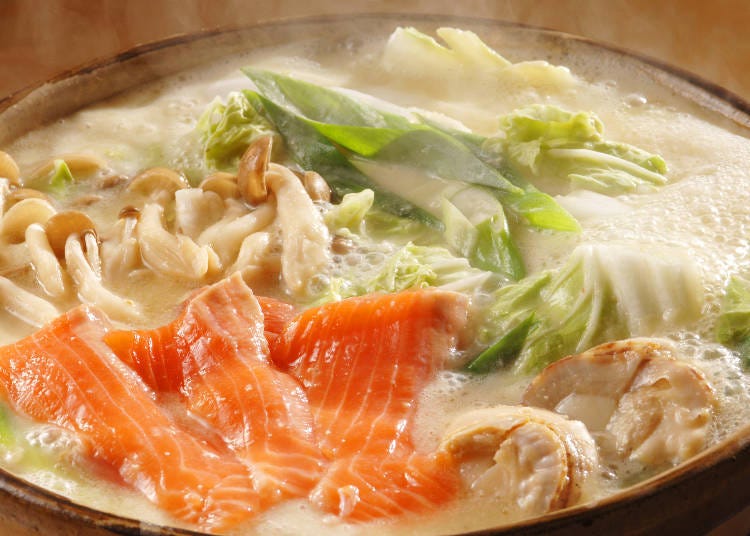
After the boom in the 2000s, soup curry has continued to thrive as a hearty staple dish considered one of Sapporo's “soul foods.”
When visiting Sapporo to explore the local gourmet culture, definitely include at least one soup curry! Of course, with such a vast assortment of outlets serving different renditions of the dish, figuring out which to visit can feel a tad overwhelming.
To help out, we’ve rounded up a selection of four of the most popular soup curry restaurants in Sapporo. Visiting any one of these highly regarded establishments will ensure you’re getting the absolute cream of the crop!
1. Sapporo Rakkyo: A Nourishing, Homely Taste
The first soup curry restaurant we’d like to share is Sapporo Rakkyo, run by the previously introduced Ide Go. Rakkyo can be found just a brief 2-minute walk from the south exit of Kotoni Station, which is two stops away from Sapporo Station on the Hakodate Line. This is the chain’s main restaurant, with several others in and outside Sapporo.
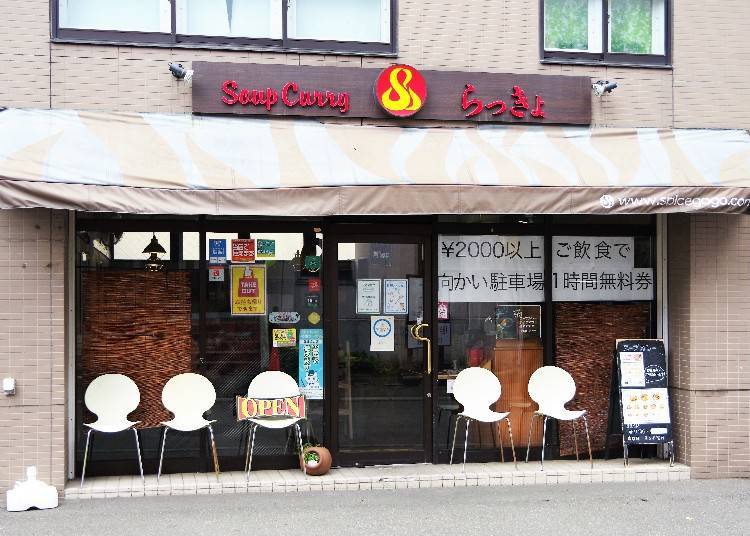
Rakkyo opened its doors in 1999, riding the soup curry boom of the early 2000s. While following the recipe of a legendary old-school restaurant, they pursued a fresh, widely agreeable flavor forming a neo-classic soup curry.
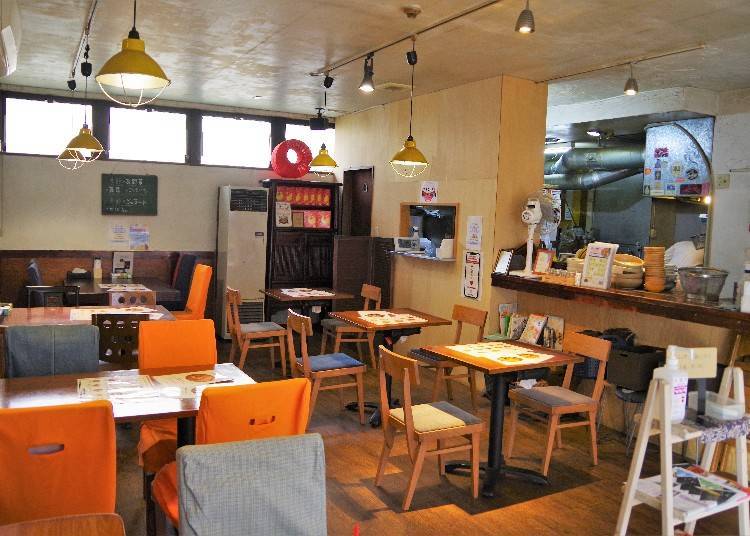
The soup base is made from a range of onions, tomatoes, chicken carcass, pork bones, and even beef. With no artificial flavors, one can fully relish the unspoiled flavors of each ingredient weaving together a thick, luscious taste. The sweetness of the onion melted into the soup further draws out the spice to enrich the overall flavor.
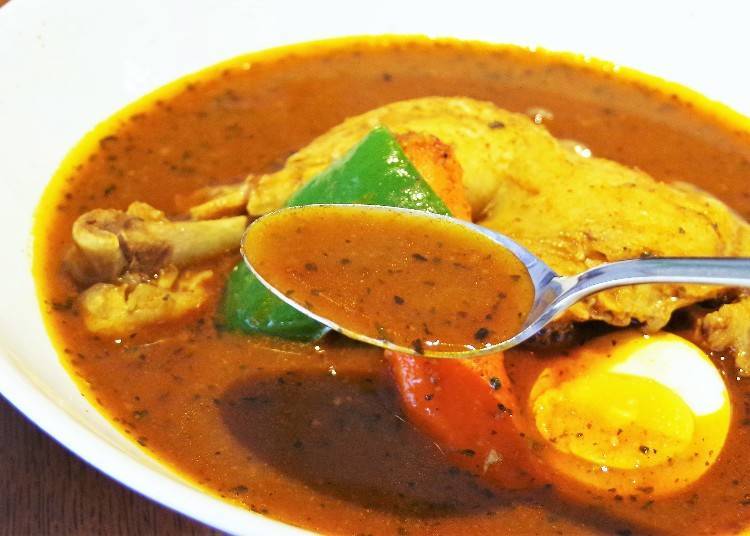
The most popular menu item is the “Hokkaido-Made Shiretoko Chicken and Vegetable Soup Curry” (1,600 yen). The carrots and other vegetables are largely sourced from within Hokkaido, as are the chicken and boiled eggs. The rice, which is also grown in Hokkaido, is served with two small pieces of nori for a final kick of flavor.
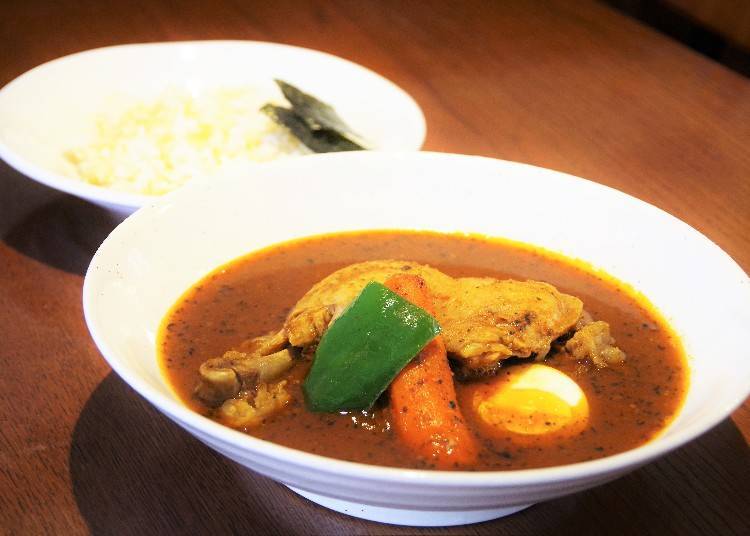
While the soup and ingredients don't have any particular peculiarities, that in itself exemplifies the simple and hearty character of Sapporo soup curry. No matter how many exciting, innovative renditions you try afterward, you’ll surely return to this homespun, nourishing dish.
Health & Safety Measures
Indoor disinfection measures taken - Sanitizer installed - Disinfected after each guest leaves - Ventilation measures in place - Coin trays used - Staff wear masks, gargle, wash hands regularly, and monitor body temperature - Limited capacity/increased space between seats - Entry declined to anyone who is feeling unwell - Masks required/temperature check enforced
-
Sapporo Rakkyo札幌 らっきょ
- Address 1st Floor Capitaine Kotoni, 7-7, Kotoni 1 Jo 1 Chome, Nishi Ward, Sapporo 063-0811
-
Nearest Station
2-minute walk from Kotoni Station on the JR Hakodate Line
- Phone Number 011-642-6903
・Hours: 11:00am - 9:00pm
・Closed: 3rd Wednesday of each month
2. SUAGE+ - Scrumptious Soup and Fresh Vegetables
Our second selection is the main restaurant of SUAGE+, which sits within the central business district of Sapporo. It can be found after a 3-minute walk from Susukino Station on the Subway Namboku Line.
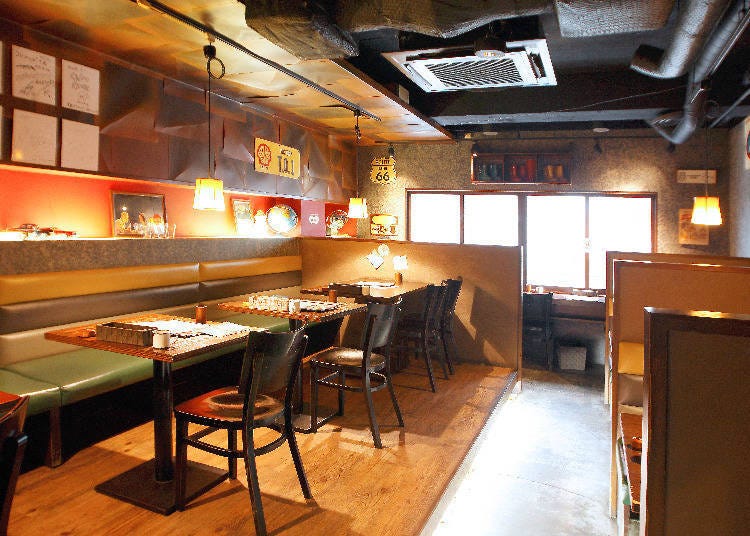
In addition to its utterly delicious soup, the main draw here are the vegetables and meats fried without batter in a Japanese cooking style called “suage,” which is also the restaurant’s name. The exquisite, fluffy rice served alongside the curry is also well worth noting.
They pay particular attention to ensuring their ingredients are sourced from within Hokkaido, with many grown by the restaurant themselves on a privately owned farm.
One of the most remarkable ingredients here is the rare “inca no mezame” potato, deep-fried in their signature style. The potato boasts a firm sweetness not unlike chestnuts, making it stand out even amongst the rich soup.

The rice, which is also primarily from Hokkaido, balances both taste and nutrition with an in-store polished white rice blended with an ancient, reddish-brown variety.
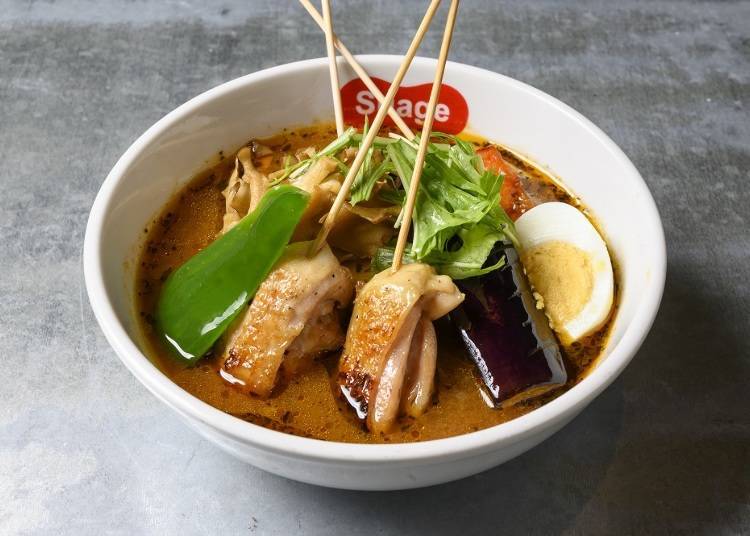
There are three kinds of soup at Suage+; the basic “Suage Soup,” the squid ink-based “Squid Black,” and the shrimp-based “Shrimp Red.”
The soup is made from vegetables like onion, tomato, carrots, and more boiled with chicken bones and flavored with an original spice mix left overnight to stew. This soup is then used without any further additions for the Suage Soup, allowing the texture and flavor of each vegetable to be appreciated to the fullest extent.
Squid Black sees this soup flavored with squid ink yielding a smooth mouthfeel with a rich, deep taste. Finally, Shrimp Red naturally features shrimp extract to weave together a soup packed with potent umami flavors.
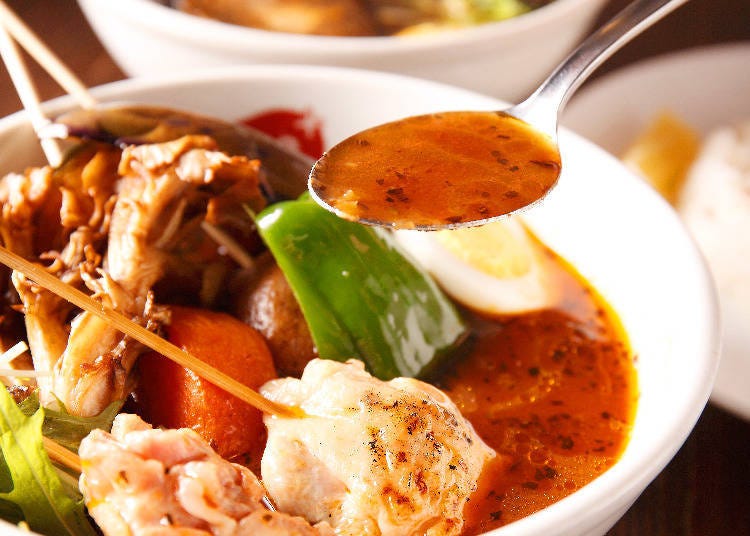
While each of the three soups is worth trying, we recommend starting with the Suage Soup and then opting for another the next time you visit. There are also additional flavors at the various SUAGE+ outlets around Sapporo and Tokyo, so don’t just stop at the three listed above!
Health & Safety Measures
Indoor disinfection measures taken - Sanitizer installed - Disinfected after each guest leaves - Ventilation measures in place - Coin trays used - Staff wear masks, gargle, wash hands regularly, and monitor body temperature - Limited capacity/increased space between seats - Restricted admission, reservation system in place - Entry declined to anyone who is feeling unwell - Masks required/temperature check enforced
-
Suage+Suage+
- Address 2F Toshimatsu Bldg. 5 Chome, Minami 4 Jonishi, Chuo Ward, Sapporo, 064-0804
-
Nearest Station
3-minute walk from Susukino Station on the Subway Namboku Line
- Phone Number 011-233-2911
・Hours:
- Weekdays: 11:30am - 9:30pm (last order: 9:30pm)
- Saturdays: 11:00am - 10:00pm (last order: 9:30pm)
- Sundays, Public Holidays: 11:00am - 9:30pm (9:00pm)
・Closed: December 31 - January 1
3. GARAKU: Super Popular Soup Curry Done Japanese-Style
Standing out amongst the abundance of soup curry restaurants in Sapporo is GARAKU, which is notorious for long lines of dedicated fans. The main outlet is located in central Sapporo and can be reached within a 3-5 minute walk from Odori Station or Susukino Station. There are also branches dotted around other locations in Sapporo, Tokyo, and even Bangkok.
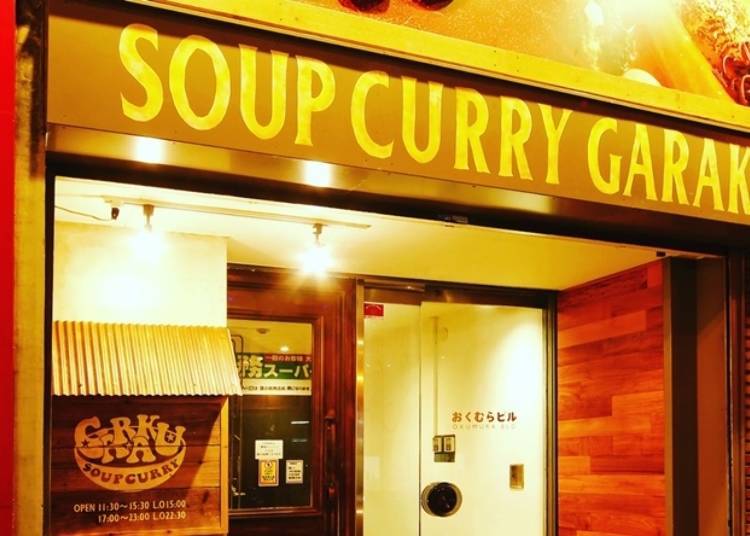
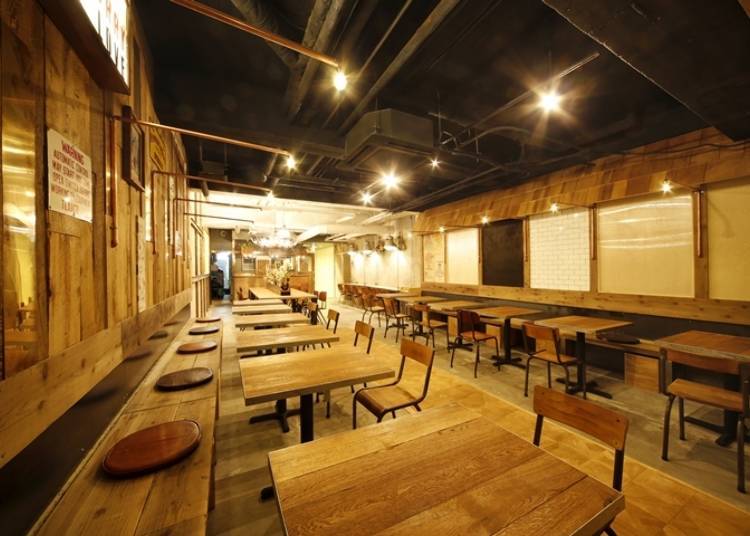
The primary reason behind the popularity of GARAKU is its original soup. The soup bouillon is made from flavors extracted by slowly boiling pork, chicken, and vegetables combined with a Japanese-style “dashi” soup of dried skipjack tuna and mackerel further flavored with 21 different spices.
While still tasting of curry, the resulting soup boasts a distinctive Japanese tang rarely seen in competing dishes.

The most popular curry dish at GARAKU is the “Torotoro Aburi Roasted Stew,” which sees homecooked cubes of pork stewed until soft roasted on high-grade charcoal.
The dish is only served until stock runs out, so whether you’ll be able to order it or not is up to luck and timing. Despite the waiting times, you won’t regret visiting once you’ve gotten your fill!
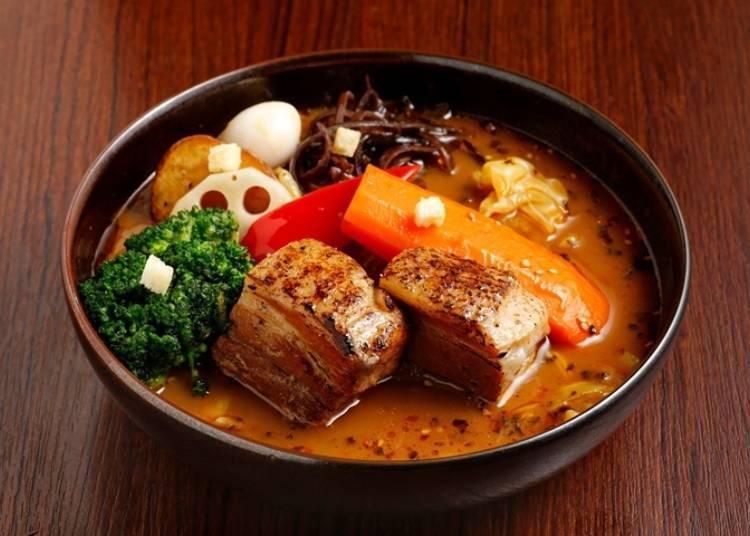
Health & Safety Measures
Indoor disinfection measures taken - Sanitizer installed - Disinfected after each guest leaves - Ventilation measures in place - Coin trays used - Plastic partitions installed - Staff wear masks, gargle, wash hands regularly, and monitor body temperature - Limited capacity/increased space between seats - Entry declined to anyone who is feeling unwell - Masks required/temperature check enforced
-
GARAKUGARAKU
- Address B1 Okumura Bldg., 2 Chome−6−1, Minami 2 Jonishi, Chuo Ward, Sapporo, Hokkaido, 060-0062 (entrance is on the north side)
-
Nearest Station
3-minute walk from Odori Station on the subway
- Phone Number 011-233-5568
・Hours: 11:30am - 3:30pm, 5:00pm - 11:30pm (last order 30 mins before)
*Until soup stocks run out
・Closed: Irregular
4. TREASURE: Taste the Evolution of GARAKU
TREASURE is the sister store of GARAKU, located just 2-3 minutes away on foot. Despite being part of the same group, the store atmosphere and soup on offer are totally different.
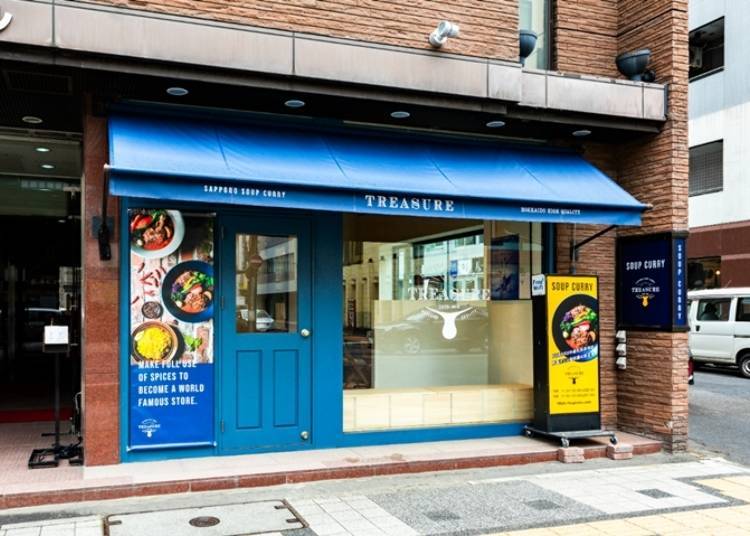
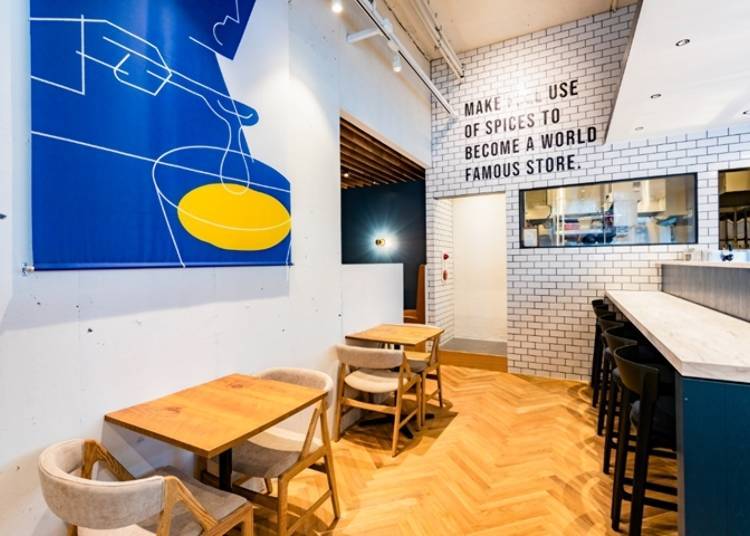
The soup curry at TREASURE is arranged from a base of GARAKU soup combined with a secret soy sauce made in-store. This soy sauce is actually made from meat and fish soaked and fermented in salt and more, technically making it more of a fish or meat sauce.
TREASURE’s original version uses minced pork as the base, allowing one to relish a subtle yet pronounced Japanese flavor complementing the curry.
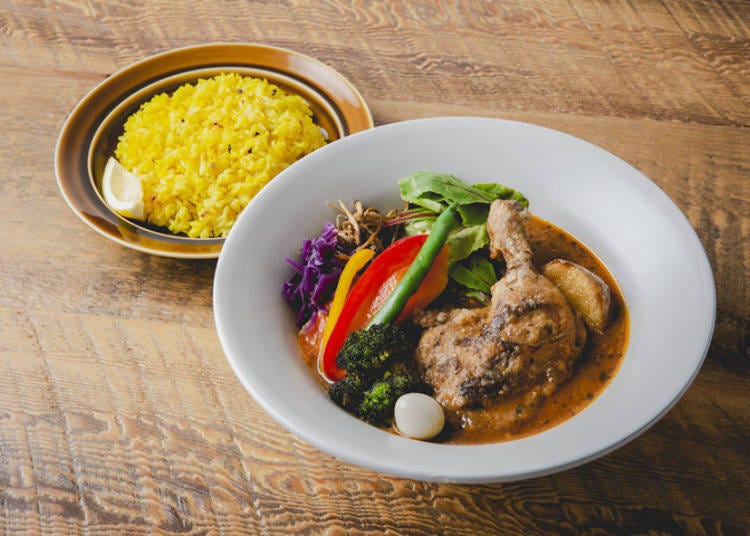
The most requested dish here is the “Sakutto Fried Leg,” which features a chicken leg with melt-in-your-mouth stewed meat battered and fried to perfection.
The crisp batter becomes soft after being soaked in the soup, while the thick cut of juicy chicken locked inside explodes with a warm, nourishing taste. Alongside the meat and vegetables, the soup itself is absolutely scrumptious and worth taking the time to savor thoroughly.
Health & Safety Measures
Indoor disinfection measures taken - Sanitizer installed - Disinfected after each guest leaves - Ventilation measures in place - Coin trays used - Plastic partitions installed - Staff wear masks, gargle, wash hands regularly, and monitor body temperature - Limited capacity/increased space between seats - Restricted admission, reservation system in place - Entry declined to anyone who is feeling unwell - Masks required/temperature check enforced
-
TREASURETREASURE
- Address 1F Asuka Bldg., 1 Chome−8−2, Minami 2 Jonishi, Chuo Ward, Sapporo, Hokkaido, 060-0062
-
Nearest Station
3-minute walk from Odori Station on the subway
- Phone Number 011-233-5568
・Hours: 11:30am - 3:30pm, 5:00pm - 8:30pm (last order 30 mins before closing)
・Closed: Irregular
Alongside miso ramen and shime parfait, soup curry is steadily becoming the most iconic food of Sapporo. Even outside Hokkaido, this hearty dish is beloved across all the prefectures of Japan, with outlets popping up in cities like Tokyo, Osaka, and more.
Despite this, Sapporo remains the soup curry homeland, with so many outlets it would take a lifetime to taste them all! Next time you’re in this gourmet capital, make room for a couple of bowls to warm up your body like the Sapporo locals!
Text by: Nobuka Kawashima
*The information presented in this article is accurate as of December 2021. For the latest information, please check the official websites, etc.
A travel creator who has traveled all over Hokkaido in search of spectacular scenery and local gourmet food, Nobuka moved to Hokkaido from Tokyo in 2009. Since then, she has continued to photograph and write articles on Hokkaido travel and food for LIVE JAPAN and other tourism websites and travel magazines. She is a certified Hokkaido Tourism Master, a title given to Hokkaido tourism experts by the Hokkaido Chamber of Commerce and Industry, and also holds certifications as a Domestic Travel Service Supervisor and Chief Itinerary Manager. As a transgender person herself, she runs a support group to create an environment that makes travel easier for LGBTQ people, and also gives lectures and talks at universities and companies.
- Area
- Category
*Prices and options mentioned are subject to change.
*Unless stated otherwise, all prices include tax.
Popular Tours & Activitiess
Recommended places for you
-
Appealing

Rukku and Uohei
Izakaya
Sapporo / Chitose
-

LakeAkan
Rivers, Lakes & Canyons
Abashiri
-

Soup Curry ouchi
Curry
Sapporo / Chitose
-
Appealing

Noboribetsu Onsen
Hot Springs (Onsen) & Bath Houses (Sento)
Noboribetsu / Lake Toya
-

Sapporo Clock Tower
Landmarks
Sapporo / Chitose
-

SYABAZO
Curry
Sapporo / Chitose
-

Great Local Eats: 5 Expert-Recommended Local Chain Restaurants in Hakodate
by: Nobuka Kawashima
-
Ad

Cycling Through Hokkaido: Discover the Beauty of Memuro and the Tokachi Plains
-
Ad

Sapporo SATUDORA Shopping Guide: Get Souvenirs, Medicine & More at This Iconic Drugstore (Special Deal Inside!)
-
Ad

Smart Ways to Avoid Crowds and Enjoy a Safe, Comfortable Trip to Noboribetsu Onsen
-

Step into History at the Ofune World Heritage Site: Explore Hokkaido's Jomon Culture
-

7 Iconic Hokkaido locations that will make your Instagram shine
by: Himanshi Shah
-

Sapporo's 'Soul Food': 3 Recommended Soup Curry Restaurants in Japan's North
-

Japan's HUGE Northern Curry Starts With This Crazy Mountain of Rice (& A Fake Beard Discount)
-

Hakodate 2-Day Itinerary for Exploring Japan's Foodie North!
-

Top 5 Things to Do in Hokkaido's Biei and Furano Area: Shirogane Blue Pond, Lavender Fields, And More!
-

(Video) Walking Tour along Narita Omotesando - Quaint Historical Village near Narita Airport!
by: Victor Gonzalez
-

Don’t Miss These 5 Popular Local Hokkaido Chain Restaurants - For Onigiri, Curry & More
by: Nobuka Kawashima
- #best sushi hokkaido
- #things to do hokkaido
- #best ramen sapporo
- #what to bring to japan
- #new years in tokyo
- #what to buy in ameyoko
- #japanese nail trends
- #what to do in odaiba
- #onsen tattoo friendly tokyo
- #daiso
- #best sweets otaru
- #japanese fashion culture
- #best nature furano
- #japanese convenience store snacks
- #best japanese soft drinks













